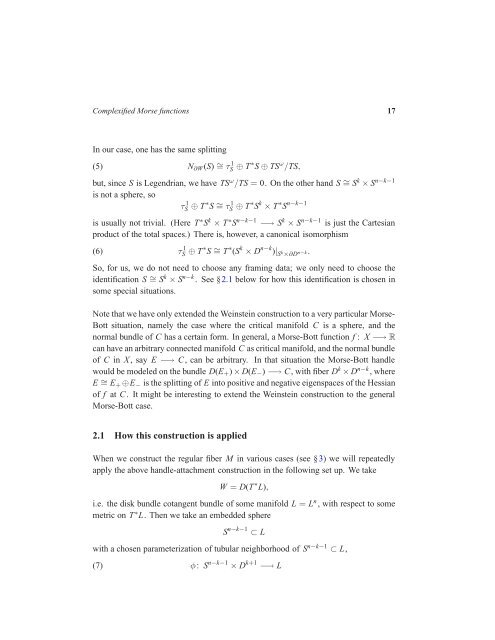The Picard-Lefschetz theory of complexified Morse functions 1 ...
The Picard-Lefschetz theory of complexified Morse functions 1 ...
The Picard-Lefschetz theory of complexified Morse functions 1 ...
You also want an ePaper? Increase the reach of your titles
YUMPU automatically turns print PDFs into web optimized ePapers that Google loves.
Complexified <strong>Morse</strong> <strong>functions</strong> 17<br />
In our case, one has the same splitting<br />
(5)<br />
N∂W(S) ∼ = τ 1 S ⊕ T∗ S ⊕ TS ω /TS,<br />
but, since S is Legendrian, we have TS ω /TS = 0. On the other hand S ∼ = S k × S n−k−1<br />
is not a sphere, so<br />
τ 1 S ⊕ T∗ S ∼ = τ 1 S ⊕ T∗ S k × T ∗ S n−k−1<br />
is usually not trivial. (Here T ∗ S k × T ∗ S n−k−1 −→ S k × S n−k−1 is just the Cartesian<br />
product <strong>of</strong> the total spaces.) <strong>The</strong>re is, however, a canonical isomorphism<br />
(6)<br />
τ 1 S ⊕ T ∗ S ∼ = T ∗ (S k × D n−k )| S k ×∂D n−k.<br />
So, for us, we do not need to choose any framing data; we only need to choose the<br />
identification S ∼ = S k × S n−k . See §2.1 below for how this identification is chosen in<br />
some special situations.<br />
Note that we have only extended the Weinstein construction to a very particular <strong>Morse</strong>-<br />
Bott situation, namely the case where the critical manifold C is a sphere, and the<br />
normal bundle <strong>of</strong> C has a certain form. In general, a <strong>Morse</strong>-Bott function f : X −→ R<br />
can have an arbitrary connected manifold C as critical manifold, and the normal bundle<br />
<strong>of</strong> C in X , say E −→ C, can be arbitrary. In that situation the <strong>Morse</strong>-Bott handle<br />
would be modeled on the bundle D(E+) × D(E−) −→ C, with fiber D k × D n−k , where<br />
E ∼ = E+ ⊕E− is the splitting <strong>of</strong> E into positive and negative eigenspaces <strong>of</strong> the Hessian<br />
<strong>of</strong> f at C. It might be interesting to extend the Weinstein construction to the general<br />
<strong>Morse</strong>-Bott case.<br />
2.1 How this construction is applied<br />
When we construct the regular fiber M in various cases (see §3) we will repeatedly<br />
apply the above handle-attachment construction in the following set up. We take<br />
W = D(T ∗ L),<br />
i.e. the disk bundle cotangent bundle <strong>of</strong> some manifold L = L n , with respect to some<br />
metric on T ∗ L. <strong>The</strong>n we take an embedded sphere<br />
S n−k−1 ⊂ L<br />
with a chosen parameterization <strong>of</strong> tubular neighborhood <strong>of</strong> S n−k−1 ⊂ L,<br />
(7)<br />
φ: S n−k−1 × D k+1 −→ L
















